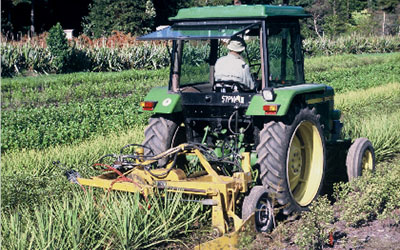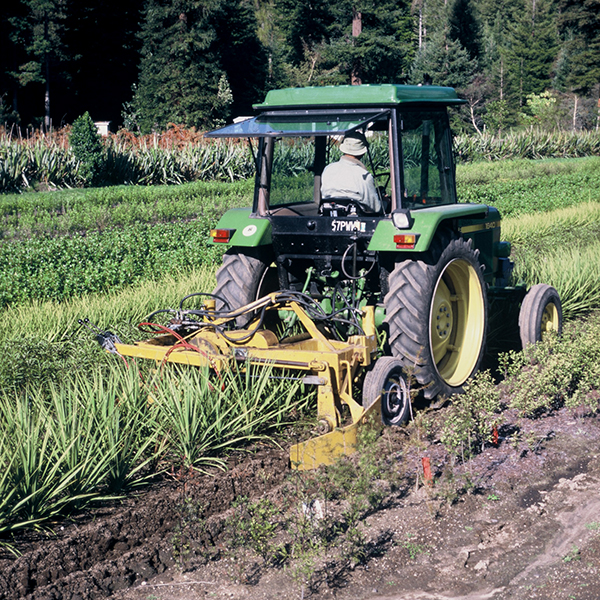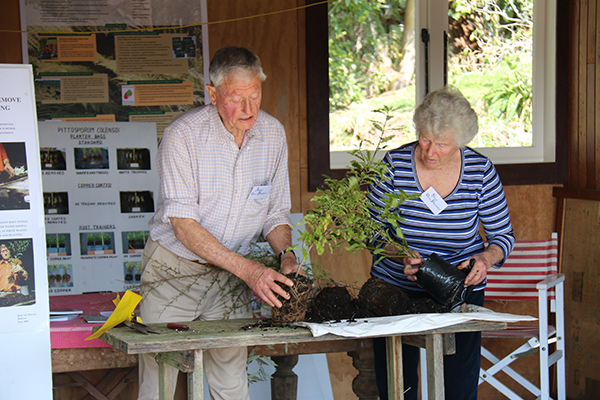Time for councils to capitalise on open-ground trials


Side-Lined By Dogma: Despite the methods being developed by the World-leading New Zealand Forest Research Institute nursery in the late 1950s, raising indigenous plants forestry-style in open-ground beds has been largely displaced by the more expensive and often problematic horticulture-style, in containers. Market forces have failed to correct this perverse situation, meaning that only a fraction of the plants go into the ground for the money expended, including that of ratepayers. Pictured are open-ground plants being under-cut in the Forest Research Institute nursery, circa 1960s. photographer Jonathan Barran
The Mahurangi trials, the Silverdale trials, and then those at Taupō, all said the same thing.
Open-ground-raised indigenous plants, in all those trials, have been found to establish every bit as well as the same species—including mānuka—produced at many times the cost in planter bags and pots.
So when it comes to spending ratepayers’ money on the good work of establishing indigenous plants, it surely behoves councils to favour projects using stock raised by the more cost-effective open-ground, or forestry-style, method. But that is not as easy as it sounds. By the time a project receives funding, it is too late to order open-ground plants. The difficulty arises because, a little like growing lettuces, if they don’t get sold they are typically of no value the following year.
In contrast, plants in pots or planter bags can be repotted and sold the following year, often at a higher price. More commonly, however, the held-over plants are not repotted and are sold to the unwary in a rootbound condition. This is more serious than it sounds, and can result in catastrophic failure of the resultant tree a decade or two later, supposing it survives that long. Roots, as wonderful as they are, are incapable of realising that having been induced to circle by the container in which they are grown, should cease and desist and leave the heavy lifting to some young root that now has a clear run at venturing forth in a wholesome direction.
The current impasse is unlikely to be resolved by market forces. Individual nurseries have no incentive to speculatively grow plants for the fledgling open-ground indigenous plant market when they can make more money by sticking with the containers. Likewise, organisers of planting projects have no incentive to elect to use open-ground plants when funding agencies are prepared to pay for the more expensive container-raised plants. The solution is to take a leaf out of Pharmac’s book. Councils would place standing orders with nurseries capable of supplying good quality open-ground indigenous plants. Community groups, when applying for council assistance with planting projects, would have the option of indicating that they were prepared to use council-sourced open-ground plants as opposed to purchasing their own, in the knowledge that by so doing they improved the eligibility of their project for funding. Thus, council funding of planting projects would see at least twice the number of plants in the ground for the same money.
The particular beauty of the concept is that the option of using open-ground plants would be brought to the attention of every applicant of every project that involved establishing indigenous plants. It would mean additional work for council staff in explaining what open-ground plants were and what the implications of using them might be. But here, the application process itself could do much of the educating, as illustrated in this faux council form:

Open-Ground Guru: So acutely aware of the futility of planting plants that are rootbound or exhibit root circling, Jaap van Dorsser, pictured with his wife, Sue, at the Tāne’s Tree Trust annual general meeting on Saturday, has insisted that every container-raised plant established at the monumental Awahou Stream riparian restoration project he is largely responsible for, is first debagged and root-pruned. Aside from assuring that everything planted is free of the root aberrations that can all too frequently cause young and old trees to fail catastrophically, the logistics of getting the bare-rooted plants to the planting sites is greatly enhanced. Losses are close to zero. photographer Michael Bergin
Over time, as more and more groups became familiar with deploying open-ground plants, and memories faded of the bad old days of lugging heavy and expensive, and more-often-than-not rootbound, container-raised plants over typically difficult terrain, the percentage of council-funded plants purchased that were raised by the open-ground method could be increased. This would give commercial nurseries ample time to adapt to the new market, and compete to supply councils. Long-term, councils, in theory, would have no need to act as supplier—not that they would ever need to physically handle the open-ground plants, which would go directly from nursery to planting site on the pre-arranged date. Arguably, once a market had been established for them, by the council funding programmes, nurseries could grow the open-ground plants in anticipation of demand. However the real world tends to make a mockery of market economic theory, and it is probable that a Pharmac-style mechanism would be of long-term benefit to both the nurseries and councils—growing plants speculatively can lead to considerable inefficiencies, and even wholesale waste when a crop has to be ploughed in due to a lack of demand. Also, councils would be in a stronger position, with their growing contracts, to ensure that the plants going to council-funded projects were of adequate quality—individual community groups would be poorly placed to ascertain whether the stock they were about to plant had been undercut, wrenched, irrigated and otherwise prepared and harvested in a timely and proficient manner, and thus were fit for purpose.
The mission to revive the considerably more cost-effective open-ground method of producing open-ground plants, which was pioneered by Forest Research Institute’s legendary head nurseryman Jaap van Dorsser in the late 1950s, has made considerable progress since the Mahurangi trails commenced in 2007. Landcorp Farming is now exclusively ordering open-ground plants when sourcing them from The Native Plant Nursery at Taupō—one of the few nurseries currently offering plants indigenous to Aotearoa raised by that method. Meanwhile, the use of open-ground plants must be considered by the builders of the Pūhoi–Warkworth motorway, as the result of Mahurangi Action’s submission opposing that carbon-intensive project. But aside from the plants used by Mahurangi Action, both in the original trials and since, neither the Mahurangi catchment nor the rest of the country is yet benefitting from the advantages of open-ground. A further option has been suggested, whereby a council could establish its own open-ground nursery, and provide the plants free of charge, or at nominal cost, to community projects. While this would raise the usual objections on behalf of the sanctity of the market, the more important consideration is that it would be of no assistance the many holders of private property who are strongly motivated to establish indigenous plants on their land, whether for restoration, amenity or productive purposes.
It could be argued that the establishment of such council nurseries would incentivise the private sector to routinely produce open-ground plants, but that still fails to address how the supply chain could be optimised to benefit producers and customers. In any event, the first phase should be establishing the Pharmac-style instrument. To this end, Mahurangi Action and Tāne’s Tree Trust are planning to put a proposal to Auckland Council that Tāne’s Tree Trust be tasked with the job of detailing the standing-order-bulk-purchase model. This work, in itself, should qualify for a small grant from the likes of Foundation North or from the council itself.
Given that The Native Plant Nursery is on record as saying that it can supply open-ground plants, in quantity, for one fifth of the price of container-raised plants, this would, no will, be a game changer.
